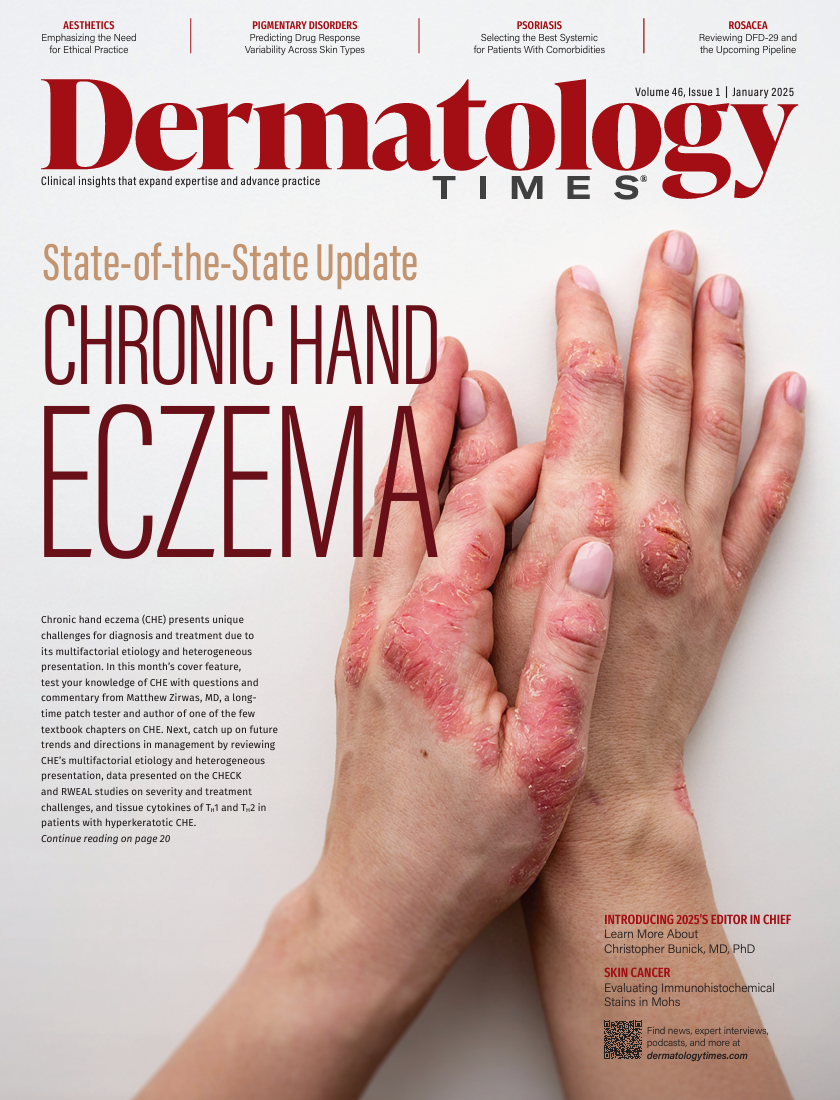- Case-Based Roundtable
- General Dermatology
- Eczema
- Chronic Hand Eczema
- Alopecia
- Aesthetics
- Vitiligo
- COVID-19
- Actinic Keratosis
- Precision Medicine and Biologics
- Rare Disease
- Wound Care
- Rosacea
- Psoriasis
- Psoriatic Arthritis
- Atopic Dermatitis
- Melasma
- NP and PA
- Skin Cancer
- Hidradenitis Suppurativa
- Drug Watch
- Pigmentary Disorders
- Acne
- Pediatric Dermatology
- Practice Management
- Prurigo Nodularis
- Buy-and-Bill
News
Article
Dermatology Times
Dermatology Times January 2025 Print Recap
Author(s):
Key Takeaways
- Chronic hand eczema research is challenging due to overlapping dermatitis types, complicating diagnosis and treatment strategies.
- Psoriasis is associated with multiple comorbidities, including obesity and depression, necessitating a systemic treatment approach.
Learn more about the in-depth topics covered in the January 2025 print issue of Dermatology Times.

The January issue of Dermatology Times includes a collection of thought-provoking articles and topics ranging from the overlooked comorbidities associated with psoriasis to the role of immunohistochemical stains in Mohs surgery. Be sure to read the highlights from the issue below. Also, don’t miss a moment of Dermatology Times by signing up for our eNewsletters and subscribing to receive the free print issue and supplement each month.
State-of-the-State Update: Chronic Hand Eczema
I’ve been a patch tester for the past 20 years and authored one of the few textbook chapters on chronic hand eczema (CHE) (Fisher’s Contact Dermatitis, 7th edition), so the condition has been near and dear to my heart for a long time. The reason there isn’t a ton about CHE in literature is that it is extremely difficult to sort out the etiology in any given patient outside seeing their response to therapy. If they improve after avoiding irritants, it’s irritant contact dermatitis (ICD). If they improve by avoiding allergens, it’s allergic contact dermatitis (ACD). If they improve with dupilumab (Dupixent; Regeneron Pharmaceuticals, Inc), it’s atopic dermatitis (AD). However, most don’t improve with any of these in isolation because most cases have overlap between ACD, ICD, and AD. It makes it difficult to do research on something when you go into the study saying, “I don’t know what the participants actually have.”
Continue Reading from Matthew Zirwas, MD
Thinking Outside the Psoriatic Box: Practical Points for Systemic Success
Psoriasis is a systemic disease; however, we as clinicians often look at it from a cutaneous perspective. Currently we are aware it is associated with metabolic syndrome, heart disease, depression, inflammatory bowel disease, nonalcoholic steatohepatitis, polycystic ovarian syndrome, arthritis, and more. Unfortunately, the current health care climate makes it difficult to coordinate care, manage and take ownership of other medical problems, and verify follow-up. However, we can use our medications in certain scenarios to tackle many of the associated comorbidities. This review highlights 2 common but overlooked comorbidities: obesity and depression.
Continue Reading from Karan Lal, DO, MS, FAAD
Identifying Ancestry-Specific Clinical End Points in Diverse Trials
The drive for inclusivity in clinical trials has never been more urgent. Historically, the clinical research landscape has often excluded sufficient representation from diverse populations, leading to potential biases in therapeutic outcomes and safety profiles. This limitation has direct consequences for clinical care, particularly when the genetic, biochemical, and physiological nuances of different ancestral backgrounds are overlooked. The integration of ancestry-specific clinical end points into research frameworks is essential to address these disparities effectively. To streamline the transition to diverse clinical trials, it is crucial to identify ancestry-specific clinical end points.
A recent article highlights the need for assessing risk related to skin tone variations and offers a scalable, cost-effective approach to predicting drug response variability across population groups.2 By leveraging cell-based assays, biochemical screening, and computational modeling, this strategy aims to account for chemical interactions with melanin.2 Such variability is also relevant in industries such as cosmetics and agriculture, where melanin-related toxicity can influence safety assessments, an area that is currently underexplored in regulatory frameworks.
The Role of Immunohistochemical Stains in Mohs Surgery
Hard of hearing and flashing a large smile, he sat down on the soft blue clinic chair after driving for 2 hours to come for Mohs micrographic surgery (MMS) treatment. He was an 80-year-old male patient referred for Mohs for a rapidly growing, poorly differentiated squamous cell carcinoma (SCC) on his scalp. It started as a small pink papule and over the past 2 months had grown to a large, crusted plaque. The aggressive nature, large size, and bizarre histological features on pathology had revealed poorly differentiated SCC cells. Sometimes the poor differentiation of a tumor can make it more difficult to identify cells on standard hematoxylin and eosin (H&E) staining.
During Mohs, the patient went 2 stages and on the final slide there was a focal area of cells that was suspicious for dense inflammation vs residual tumor. Given the original poorly defined cell morphology, definitive identification was challenging. To confirm accurate diagnosis and avoid unnecessary removal of more tissue, we used a pan cytokeratin (PanCK) immunohistochemical stain. We used this stain to clearly highlight the presence of epithelial tumor cells, confirming that there were no SCC cells and that the final margins were clear of tumor. This case employed immunohistochemistry (IHC) and its critical role in aiding decision-making during complex Mohs procedures.







